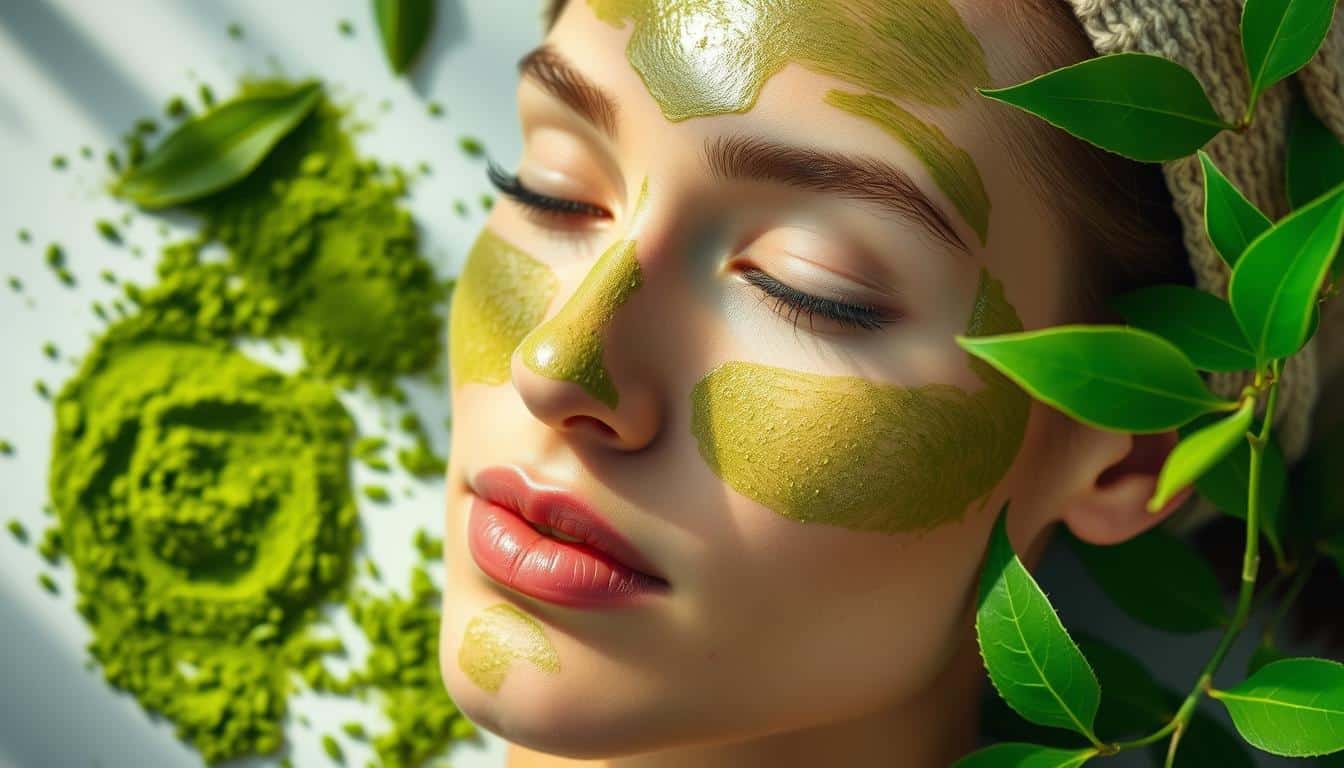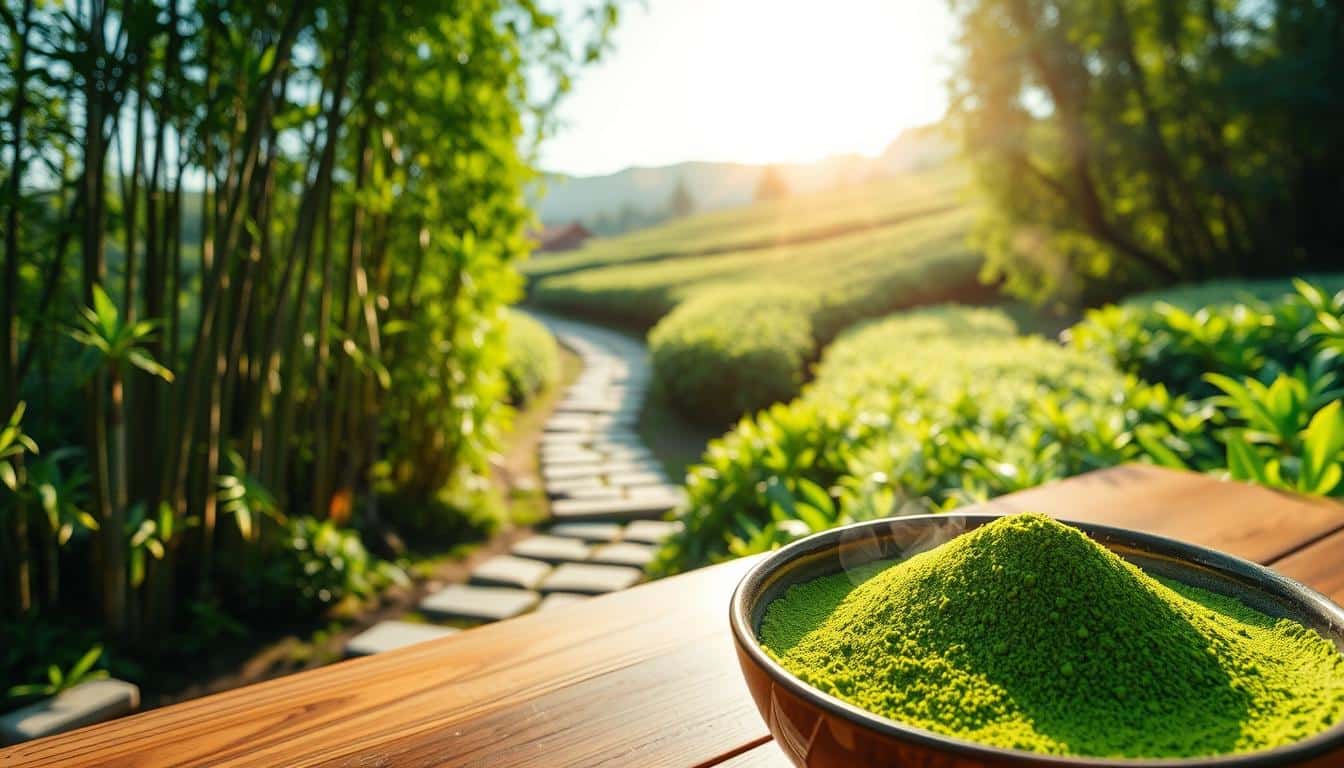Did you know matcha has more antioxidants than regular green tea? This finely powdered tea from Japan is a health powerhouse. It’s becoming a key part of daily routines for those seeking better health.
Think about replacing your coffee with matcha for a boost of energy and less anxiety. L-theanine, an amino acid in matcha, helps you relax without making you sleepy. Matcha is full of benefits, like helping with weight loss and boosting brain function. Drinking 2-3 cups a day can lead to losing 3 pounds in three months. This is why matcha is getting more popular.
Matcha is more than just a source of energy. It can lower the risk of heart disease by 11%. It also helps keep your heart healthy by managing cholesterol. Drinking matcha regularly can improve memory and recall, especially for people over 60.
If you’re interested in matcha, you might want to learn more about its journey from farm to cup. You can add it to smoothies or try new dessert recipes. For more on matcha benefits, check out this link.
Key Takeaways
- Whole foods matcha contains over 10 times the antioxidants of regular green tea.
- Consuming matcha can lower the risk of heart disease by 11%.
- Matcha supports weight loss when consumed 2-3 times daily for three months.
- L-theanine in matcha promotes relaxation and reduces anxiety without drowsiness.
- Regular matcha intake can improve cognitive function and memory, particularly in adults over 60.
Introduction to Whole Foods Matcha
Whole foods matcha is a special kind of matcha powder. It’s made from young, finely ground tea leaves. It’s known for its many health benefits. Starting with matcha green tea will show you why it’s so loved.
What Is Whole Foods Matcha?
Whole foods matcha is matcha powder that includes the whole tea leaf. It’s ground into a fine powder. This way, you get all the nutrients from the leaf, like vitamins, minerals, and antioxidants.
Unlike regular green teas, you eat the whole matcha leaves. This means you get more nutrients.
Boom in Popularity
Matcha green tea has become very popular lately. People love it for its energy boost and clear mind. Aiya Matcha is a well-known brand that sells matcha in Whole Foods Market stores.
They offer products like Organic Ceremonial Grade Matcha and Sweetened Roasted Matcha To Go. This one tastes roasted with a chocolatey finish.
Getting these matcha products is easy, which helps with their popularity. You can find Sweetened Roasted Matcha To Go in Whole Foods stores until July 5. It’s also online at aiya-america.com and Amazon.com.
Matcha tastes great and gives you energy that lasts. It’s better than coffee or energy drinks.
- Organic Ceremonial Grade Matcha
- Organic Culinary Grade Matcha
- Matcha To Go
- Sweetened Matcha To Go
- Sweetened Roasted Matcha To Go
Drinking matcha can help with weight and stress. Since 1990, tea sales have almost quadrupled, says the Tea Association of the USA. This shows how much people value whole foods matcha as a superfood.
The Journey from Farm to Cup
The journey of whole foods matcha from farm to cup is a detailed process. It is based on tradition and careful attention.
Cultivation Process
Matcha starts with growing green tea leaves in the shade for three weeks. This makes the leaves rich in theanine and chlorophyll. It boosts health benefits and gives the leaves a unique taste.
Organic farming is used to grow matcha. It includes rotating crops and using organic compost. This keeps the soil healthy and avoids harmful chemicals.
Harvesting Techniques
Only the youngest, most tender leaves are picked for matcha. This ensures the best quality. They are picked by hand, a method used for centuries to keep the tea’s flavor and quality.
After picking, the leaves are steamed right away. This stops them from turning brown and keeps their nutrients and color.
Grinding into Fine Powder
The last step is grinding the dried leaves into a fine powder with stone mills. This careful process keeps the heat down. It helps keep the matcha’s quality and taste.
The fine powder is full of antioxidants and other good stuff. The journey from farm to cup shows the hard work and skill needed for this special tea.
Types of Matcha: Organic and Non-Organic
When you explore matcha, you’ll find two main types: organic and non-organic. Each type has its own benefits and differences. The main difference is how they are grown.
What Is Organic Matcha?
Organic matcha doesn’t use synthetic pesticides or fertilizers. It’s grown with sustainable methods like crop rotation and organic compost. People think it tastes purer and is more nutritious. It also has fewer contaminants than non-organic matcha.
- Free from synthetic pesticides and fertilizers.
- Sustainable matcha farming methods employed.
- Believed to offer a purer flavor and higher nutrient content.
Non-Organic Matcha Explained
Non-organic matcha might use modern farming methods with synthetic pesticides and fertilizers. This can make it cheaper. It still has health benefits but might have fewer nutrients than organic matcha because of pesticides.
- May be grown using synthetic pesticides and fertilizers.
- Typically more affordable than organic matcha.
- Offers health benefits but may have fewer nutrients.
| Brand | Price per Serving | Performance | Overall Ranking |
|---|---|---|---|
| Matcha Wakatake | $0.97 | Excellent foam and bubbles | 1 |
| Trader Joe’s Matcha Green Tea Powder | $7.49 | Good foam, smaller serving size | 2 |
| Republic of Tea Organic Matcha | $0.88 | Poor foaming ability, large bubbles | – |
| Matchaful Kiwami | — | Clumps observed | 3 |
Nutritional Profile of Whole Foods Matcha
Whole Foods Matcha is a treat for health lovers. It has only 70 calories per serving and is packed with nutrients. It’s fat-free and has 17 grams of carbs, with 17 grams of sugar. This sugar makes up 34% of your daily need.
It also has a low sodium level of 36 mg, which is just 2% of your daily intake.
Antioxidants and Catechins
Matcha is full of antioxidants, especially catechins. These help fight off harmful free radicals in your body. Since you eat the whole leaf, not just a tea bag, matcha has more antioxidants than other green teas.
Vitamins and Minerals
Whole Foods Matcha is full of vitamins and minerals. You get potassium, vitamin C, iron, and calcium in each serving. It’s mostly water, so it also helps you stay hydrated. Even without all vitamins and minerals listed, matcha is still a great choice for health.
For more details on matcha’s nutrition, check out here.
Difference with Regular Green Tea
Matcha is different from regular green tea. It has more nutrients because it’s made from ground tea leaves. This means more antioxidants, catechins, and L-Theanine for energy and focus without the caffeine jitters.
Choosing matcha over regular green tea can be a smart move for your health.
Enjoy the health benefits of Whole Foods Matcha in your daily diet.
Health Benefits: What Matcha Can Do for You
Adding matcha to your daily routine brings many health perks. It has caffeine and L-Theanine which boost your metabolism and help with focus and memory. Matcha is full of antioxidants, which are good for your heart by keeping cholesterol levels in check and lowering heart disease risk. It also helps you feel calm yet alert, perfect for meditation or a busy day at work. So, matcha is a great addition to your health plan, offering a complete way to improve your well-being.
Boosts Metabolism
Matcha is great for boosting your metabolism. It has more epigallocatechin gallate (EGCG) than regular green tea, about 140 times more. These catechins help your body burn calories better, which is good for weight management. Plus, matcha’s polysaccharides help keep your blood sugar stable, which is good news for diabetes patients.
Supports Mental Clarity and Focus
Matcha is known for making you mentally clear and focused. It has caffeine and L-Theanine that keep you alert but calm. This mix improves your mood, helps you concentrate better, and makes you think faster. Studies show that drinking matcha regularly can also boost your memory, increase alertness, and protect against losing your mental sharpness. It’s perfect for a morning pick-me-up or an afternoon energy boost.
Promotes Heart Health
Eating matcha is good for your heart. It may even lower the chance of breast cancer by 27% for women who drink lots of green tea. Matcha’s antioxidants help control cholesterol, lowering heart disease risk. Its antioxidants and anti-inflammatory effects can also strengthen your heart. So, matcha is a smart choice for keeping your heart healthy.
Matcha and Skin Health
Adding matcha to your daily routine can greatly improve your skin’s health. It’s full of antioxidants that protect your skin from harm and slow down aging.

Antioxidants for Skin Protection
Matcha is packed with antioxidants, more than any other superfood. It has 1384 units per gram in the ORAC test. These antioxidants, like catechins, protect your skin from the sun and stress.
They fight off free radicals, which can damage your skin. Using matcha daily can make your skin clearer and more glowing. It also helps reduce inflammation and catch free radicals, making it great for your skin.
Anti-Aging Properties
Matcha is known for its anti-aging effects. Its antioxidants, such as EGCG, slow down aging and make skin more elastic. Using matcha as a face mask can make your skin look smoother and younger.
It also reduces acne and makes your skin healthier and smoother. Adding matcha to your skincare routine can greatly improve your skin’s look and feel.
Whole Foods Matcha in Daily Routine
Adding whole foods matcha to your daily routine can make you feel refreshed and healthy. Its bright green color and unique taste make it a great choice for your lifestyle.
How to Make Matcha Tea
Start by picking a top-quality matcha powder for making tea. Sift 1-2 teaspoons into a bowl to avoid lumps. Then, add hot water (about 175°F) and whisk with a bamboo whisk until frothy.
After that, pour more hot water and whisk again. This makes the tea smooth and creamy. It helps you get the best taste and health benefits from matcha.
Incorporating Matcha in Smoothies
Adding matcha to smoothies makes them more nutritious. Just put 1 teaspoon of matcha powder in your blender with things like banana, spinach, almond milk, and a bit of honey. You get a smoothie that tastes good, gives you energy, and has antioxidants for a healthy morning.
Matcha Recipes for Desserts
Matcha is great in desserts too, adding a special flavor and antioxidants. You can make matcha cookies, cheesecake, or ice cream. It makes your desserts healthier and more tasty.
For more info on matcha’s health benefits compared to other teas, check out this link.
Comparing Matcha to Other Green Teas
When looking at matcha vs green tea, it’s key to see their differences in nutrition, taste, and smell. Let’s see how matcha green tea is unique in these areas.
Nutritional Differences
Matcha has a better nutritional profile than other green teas. This is because you drink the whole tea leaf. So, you get all the nutrients like antioxidants, catechins, and amino acids. Traditional green teas have you steep and throw away the leaves, so you get fewer nutrients.
Matcha’s high chlorophyll makes it bright green and gives it big health benefits.
Flavor and Aroma
The flavor profile of matcha green tea is special. It tastes rich and umami with a hint of sweetness. This is different from the bitter taste of other green teas. Matcha lovers enjoy this unique taste and its versatility in cooking.
The matcha aroma is also unique, smelling fresh and vegetal. This shows its high quality, especially in ceremonial-grade matcha.
Here is a detailed comparison of matcha and other green teas:
| Aspect | Matcha | Other Green Teas |
|---|---|---|
| Consumption | Whole leaf | Steeped essence |
| Nutritional Content | High | Moderate |
| Flavor Profile | Umami, slight sweetness | Bitter |
| Aroma | Fresh, vegetal | Mild, earthy |
| Color | Bright green | Muted green |
| Preparation | Whisked in water | Steeped in hot water |
Potential Side Effects and Considerations
Matcha is good for your health, but it has some side effects to know about. The caffeine in it can cause problems for those who are sensitive to it. These problems include trouble sleeping, headaches, and high blood pressure.
It’s also key to know about matcha quality and where it comes from. This helps you make a smart choice when buying.

Caffeine Sensitivity
Matcha has more caffeine than regular green tea. Just one teaspoon of it can have 75.6 to 177.6 mg of caffeine. If you’re sensitive to caffeine, this could lead to trouble sleeping, feeling restless, or having a fast heartbeat.
Start with a little bit and see how you feel before taking more. Pregnant women and people with health issues should be careful or talk to a doctor before trying matcha.
Quality and Sourcing
The quality of matcha really matters for its effects and safety. You want high-quality matcha to avoid bad additives or too many pesticides. When picking a brand, choose ones that grow their tea the right way and are open about it.
This way, you get a tasty matcha that’s also good for you. Buying from trusted sources means you’re getting a product that meets high standards. This gives you peace of mind and better health benefits.
The Environmental Impact of Matcha Cultivation
Looking into matcha cultivation shows us its big impact on the environment. Organic matcha farming is known for its green ways. These methods keep the earth safe and make the soil richer, helping farming last longer.
Sustainability in Organic Farming
Organic matcha farming is a top choice for being green. It skips synthetic chemicals and grows many crops together. This cuts down on harm to the environment a lot.
For example, making one kilogram of organic matcha uses about 8,000 liters of water. It also makes much less waste than other foods like lamb. Plus, making matcha creates only 1.9 kilograms of CO2 per kilogram of tea. This is way less than coffee, making matcha a better pick for the planet. You can learn more about matcha’s health and green benefits here.
Ethical Considerations in Non-Organic Production
Non-organic matcha might be cheaper, but it has its downsides. Using pesticides and fertilizers is bad for you and the earth. For example, making non-organic matcha uses more water and harms the environment more.
It can also pollute water and harm the soil. So, thinking about these issues is key to choosing matcha responsibly.
| Environmental Aspect | Organic Matcha | Non-Organic Matcha |
|---|---|---|
| Water Usage (Liters per Kg) | 8,000 | 8,856 |
| Carbon Footprint (Kg CO2 per Kg) | 1.9 | Higher due to synthetic fertilizers |
| Waste Produced (Kg per Kg) | 1.9 | Higher |
| Use of Synthetic Chemicals | None | Yes |
| Sustainability Practices | High | Low |
Choosing the Right Matcha for You
Choosing the right matcha means looking at flavor, quality, price, and brand. Knowing these things helps you enjoy great matcha and save money.
Factors to Consider
Start by checking the color and texture of the matcha. Good matcha is bright green and very fine. Republic of Tea Organic Matcha had a yellow color and clumps, so it was not top quality.
Trader Joe’s and Matcha Wakatake were much better, with bright green colors and fine textures. The crema quality is also key. Matcha Wakatake and Trader Joe’s made rich cremas with tight bubbles, making for a great experience.
Brands and Pricing
Matcha prices change a lot by brand and quality. Here’s a look at some popular matcha brands and their prices per ounce:
| Brand | Price per Ounce | Rating | Price Rating |
|---|---|---|---|
| Ujido – matcha green tea powder | $4.99 | ⭐⭐ | 💲 |
| Mighty Leaf – organic matcha green tea | $9.99 | ⭐⭐⭐⭐ | 💲💲 |
| Aiya – matcha ceremonial grade | $16.99 | ⭐⭐⭐⭐ | 💲💲💲 |
| matcha LOVE – stone ground green tea powder (organic) | $18.56-$21.40 | ⭐⭐⭐⭐⭐ | 💲💲💲💲 |
| PURE LEAF – matcha PURE | $22.47 | ⭐⭐⭐⭐ | 💲💲💲💲💲 |
Trader Joe’s matcha costs more at $7.49 per serving because it’s in smaller sizes. Always think about the price and how much you get.
Certifications and Quality
Check for matcha quality certifications like JAS and USDA Organic. These show the matcha meets high standards and is organic. They mean the matcha is free from harmful pesticides and additives.
Choosing matcha from trusted brands with these certifications lets you enjoy your tea without worry.
Conclusion
Our journey through whole foods matcha shows it’s a top choice for health and culture. We learned about its amazing nutrition. Matcha has 137 times more antioxidants than regular green tea. It’s like drinking 7 to 10 cups of regular green tea in one go.
Matcha is packed with nutrients and has a special taste. It has catechin EGCg, which fights bad cells and boosts metabolism. It also has L-theanine, which helps you relax, just like coffee but without the jitters.
Adding matcha to your day is easy, whether you pick top brands or easy-to-use options. You can make traditional Japanese tea or try it in lattes, smoothies, and baked goods. Remember, knowing how to pick and prepare matcha makes it even better for you.


